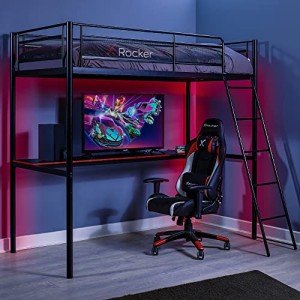5 Laws That'll Help The Bunk Bed Industry

A Comprehensive Guide to Children's Bunk Beds: Styles, Benefits, and Safety Considerations
Bunk beds have ended up being a popular choice for families aiming to make the most of space and provide a fun sleeping environment for kids. With their unique style, they offer an imaginative and practical service for shared bedrooms, playrooms, or perhaps guest lodging. This article explores the numerous designs of kids's bunk beds, their advantages, security factors to consider, and addresses some regularly asked concerns.
The Allure of Bunk Beds
Kid's bunk beds are more than just space-saving structures; they are also a gateway to adventurous dreams and imaginative play. Below is a comprehensive evaluation of their numerous benefits.
Benefits of Bunk Beds
- Space-Saving: Bunk beds effectively make use of vertical space, making them an ideal option for smaller rooms.
- Playful Design: Many bunk bed designs include slides, tents, and themed aspects, triggering imagination and excitement.
- Partner Sharing: Bunk beds are perfect for brother or sisters sharing a space or accommodating sleepovers.
- Flexible Use: Some models can be separated into 2 specific beds, offering flexibility as children grow.
- Storage Options: Many bunk beds come with built-in drawer storage or shelves, further enhancing their practicality.
Designs of Children's Bunk Beds
The range of bunk beds offered today accommodates different choices and needs. Below is an overview of some popular designs.
| Style | Description | Best For |
|---|---|---|
| Standard Bunk Bed | A conventional design including one bed stacked above another. | Brother or sisters sharing a room. |
| Loft Bed | Similar to a bunk bed without the bottom bunk, allows for a workspace or play area below. | Restricted space for play/desk. |
| L-Shaped Bunk Bed | Two beds arranged in an L-shape, frequently with extra areas for storage or play. | Unique space layouts. |
| Twin Over Full | A twin bed over a full bed, accommodating various sleep needs. | Growing children and teens. |
| High Sleeper | Stands even greater than a loft bed, normally featuring a desk or play area below. | Older kids needing more play/desk space. |
| Camping Tent Bunk Bed | Bunk beds with a canopy or tent-like structure, developing a cozy, fun space. | Active and imaginative children. |
Key Features to Consider
When picking the best bunk bed for children, the following features are worth thinking about:
- Material: Bunk beds can be made from wood, metal, or a mix. Each has its special visual and sturdiness.
- Weight Capacity: Always validate the weight limit of the bunk bed to ensure it can accommodate your kids safely.
- Security Rails: Ensure the leading bunk has sturdy rails to avoid falls.
- Ladder Security: A properly designed ladder should use simple and safe access to the upper bunk.
- Completing: Ensure any finishes are non-toxic and safe for kids.
Safety Considerations
Safety is critical when it concerns children's bunk beds. The following guidelines need to be complied with:
- Age Appropriateness: Generally, kids under 6 years of ages need to not sleep in the upper bunk due to security risks.
- Tough Construction: Ensure the frame and products are strong and can support the weight without drooping.
- Regular Maintenance: Periodically examine for loose screws, bolts, or other components that may need tightening up.
- Clear Play Area: Keep the area around the bunk bed without toys and challenges to reduce tripping hazards.
Setting Rules for Safe Use
Establishing guidelines for bunk bed use will help make sure security:
- Limit Jumping and Climbing: Children ought to be encouraged against jumping from the leading bunk and climbing up on the sides.
- Monitoring Sleepovers: Monitor young visitors while they are using the bunk bed for the very first time.
- Educate on Ladder Use: Teach how to utilize the ladder securely, highlighting the importance of dealing with the ladder when climbing or down.
Often Asked Questions
1. What age is suitable for a kid to sleep in the top bunk?
Many manufacturers advise that children must be at least six years of ages to oversleep the upper bunk. This standard is designed to alleviate the threat of falls.
2. Can bunk beds be tailored?
Yes, numerous manufacturers offer customizable alternatives, consisting of colors, products, and extra features like drawers or desks.
3. Are bunk beds safe for weight?
Bunk beds have weight limitations, generally varying from 200 to 400 pounds, depending upon the design and material. Constantly check the producer's specifications.
4. How do her response keep and clean up a bunk bed?
Routinely look for loose parts, keep the bed tidy by cleaning down surfaces, and ensure the bed linen is fresh to promote a safe and sanitary sleep environment.
5. Can bunk beds be separated into specific beds?
Lots of bunk beds feature a choice to separate them into two private beds, offering long-lasting flexibility.
Kid's bunk beds are more than simple furnishings; they are a functional, versatile, and creative element of a kid's space. With numerous styles readily available and many safety factors to consider to keep in mind, parents can select the best bed that fits their space, fulfills their kids's needs, and imparts a sense of adventure. By comprehending the benefits, designs, and precaution related to bunk beds, households can create a wonderful and secure sleeping environment for their kids. Whether for siblings sharing a space or space-saving options, bunk beds stay a beloved choice for many homes.

